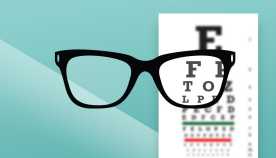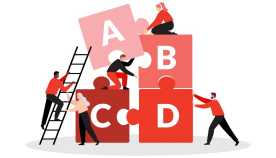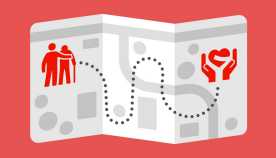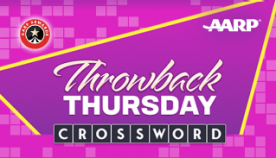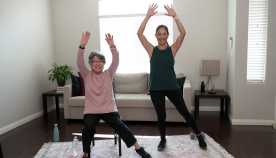Survey says adults who exercise, regularly, rate their brain health significantly higher
WASHINGTON, DC — Brain health could be as simple as putting your right foot in front of your left! The majority of adults 40+ are not meeting the recommended 2.5 hours of moderate to vigorous exercise per week, according to AARP’s latest healthy aging survey. Those 40+ who do exercise, regularly, rate their brain health significantly higher than non-exercisers, citing improvements in their ability to: learn new things, manage stress, and make decisions.
These findings directly align with recommendations that can be found within the Staying Sharp program, an exciting new brain health offering from AARP. Staying Sharp is a digital platform that promotes brain health through holistic advice supported by science. The platform also provides users with a brain health assessment in order to deliver a personalized program spanning across five key focus areas:
- MOVE – Keeping fit
- NOURISH – Eating right
- RELAX – Managing stress
- DISCOVER – Discovering new things
- CONNECT – Being social
“With Staying Sharp, we sought to empower consumers with the tools needed to create a holistically brain healthy environment for themselves—along with a way to track and measure their progress,” said Craig Fontenot, VP of Value Creation. “The results of this survey only further validate the advice suggested on the platform and give us confidence that we’re providing our members with helpful, impactful information.”
Exercise Habits of the 40+
More than half (56%) of adults age 40+ say that they get some form of exercise each week. However, only about a third (34%) of people actually achieve the recommended 2 ½ hours of moderate to vigorous activity each week. There was little difference in reported amounts of exercise by age or gender. Walking was the number one most commonly-reported physical activity among adults.
Asian-American adults reported some form of weekly exercise at a higher rate than did Whites or Hispanic/Latinos; African-Americans had the lowest rate of exercise.
Top 5 Most Commonly Reported Physical Activities
Walking for exercise 53%
Walking for leisure 46%
Walking around at work 41%
Yardwork/gardening 40%
Flexibility exercises 20%
Barriers to Exercise
The top reason adults gave for not exercising? “I really do not enjoy exercise.”
The reasons adults gave for not exercising were varied, but some of the most common included: not having the willpower to exercise, not viewing themselves as the “exercise type,” feeling too tired to exercise, or feeling that it cost too much money to exercise.
About 25% of adults said they did not see a need to exercise regularly and were satisfied being sedentary.
The Link between Exercise and Brain Health
Staying Sharp’s fitness focus area is specifically geared towards using physical exercise as a catalyst to promote brain heath. We found that those who exercised on a regular basis ranked their brain health higher than those who didn’t exercise. In fact, adults who exercised regularly reported higher levels of improvements in their ability to solve problems, manage stress, learn new things, pay attention, and remember things in the past five years compared with people who did not regularly exercise. Many adults (67%) reporting problems remembering things do not get the recommended amounts of exercise.
About the Survey
Methodology: This online survey of a nationally representative sample of 1,530 adults age 40+ was conducted for AARP by GfK from April 29–May 15, 2016. Additional interviews were conducted among 510 Hispanic/Latino, 503 African-American, and 362 Asian-American adults age 40+. All data was weighted by age, gender, race, ethnicity, employment status, and income. The margin of error for the national sample of 1,530 adults age 40+ is +/- 2%; the margin of error was higher among subgroups.
The full results of the survey can be found here: www.aarp.org/2016SurveyOnPhysicalActivity
Additional Resources
# # #
About AARP
AARP is a nonprofit, nonpartisan organization, with a membership of nearly 38 million that helps people turn their goals and dreams into 'Real Possibilities' by changing the way America defines aging. With staffed offices in all 50 states, the District of Columbia, Puerto Rico, and the U.S. Virgin Islands, AARP works to strengthen communities and promote the issues that matter most to families such as healthcare security, financial security and personal fulfillment. AARP also advocates for individuals in the marketplace by selecting products and services of high quality and value to carry the AARP name. As a trusted source for news and information, AARP produces the world’s largest circulation magazine, AARP The Magazine and AARP Bulletin. AARP does not endorse candidates for public office or make contributions to political campaigns or candidates. To learn more, visit www.aarp.org or follow @aarp and our CEO @JoAnn_Jenkins on Twitter.
About Staying Sharp
Staying Sharp is a subscription-based application from AARP. This product is part of AARP’s commitment to provide reliable information on brain health. Staying Sharp uses a holistic approach to provide science-based, personalized tools and recommendations that allow subscribers to track and measure their brain health progress using five key focus areas or “pillars”: NOURISH (eating right), MOVE (keeping fit), RELAX (managing stress), DISCOVER (learning new things), and CONNECT (being social). To learn more, visit Staying Sharp online.
Media Contact:
Eden Godbee, 202-434-2687 media@aarp.org, @AARPMedia




